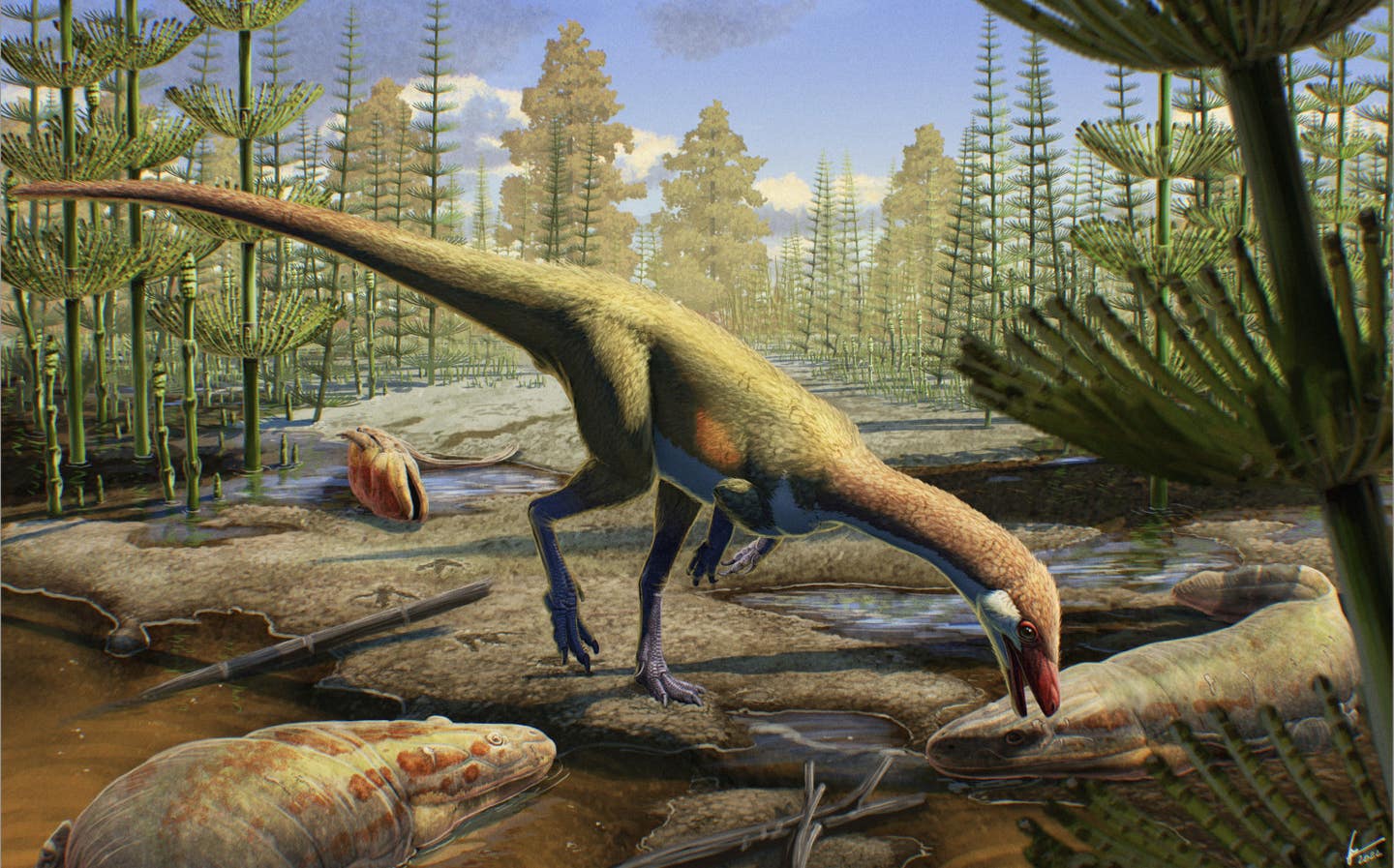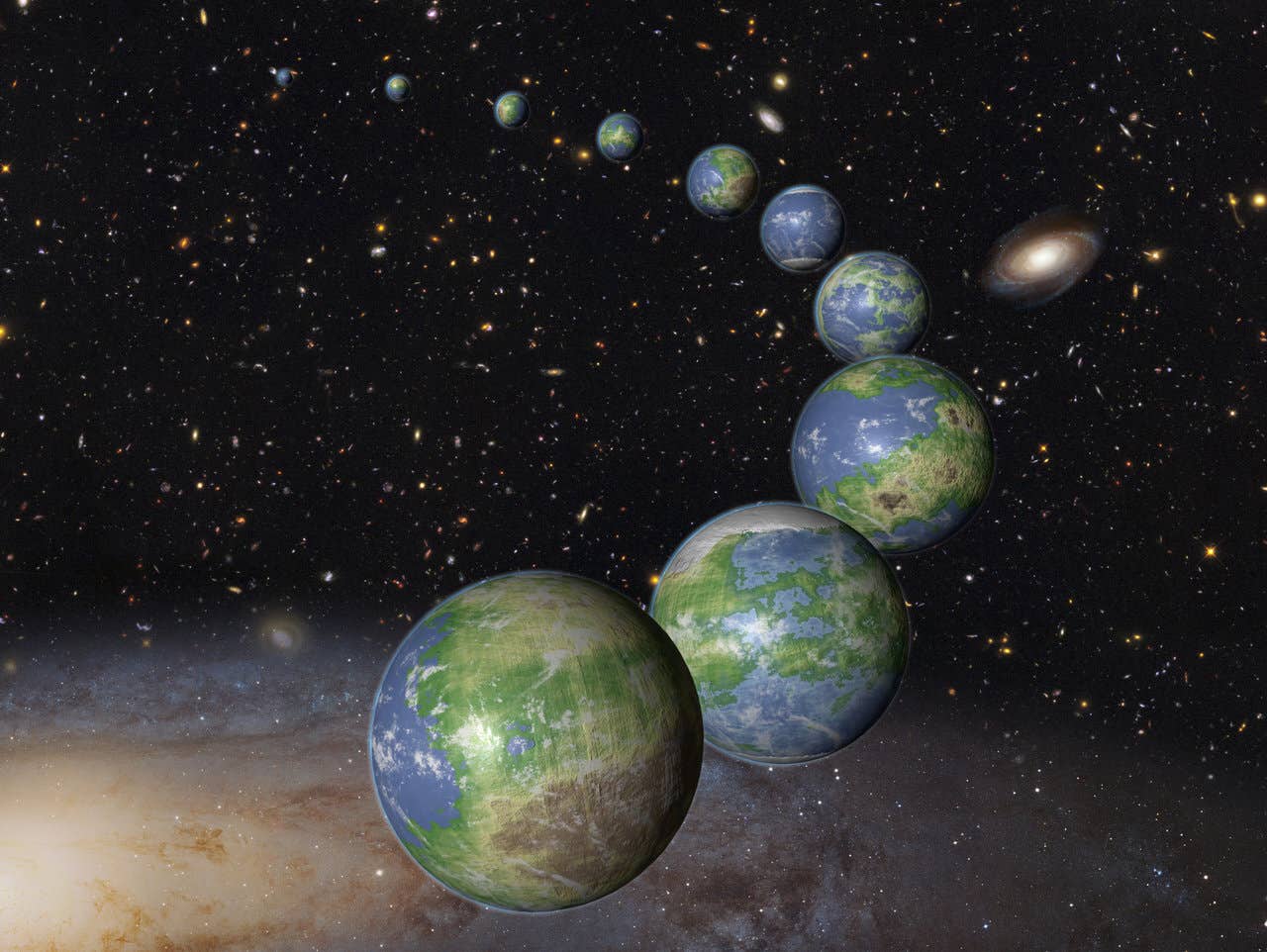Dinosaurs roamed the northern hemisphere millions of years earlier than previously thought
North America’s oldest dinosaur fossil suggests dinosaurs lived in Laurasia earlier than believed, reshaping theories on dinosaur origins.

An artist’s rendering shows how Ahvaytum bahndooiveche may have appeared in a habitat dating to around 230 million years ago. (CREDIT: Gabriel Ugueto)
More than 230 million years ago, long before giant dinosaurs thundered across Earth, a chicken-sized creature walked near the equator in what is now Wyoming. That small but mighty dinosaur is changing how scientists understand the origin and spread of one of history’s most iconic groups of animals.
For decades, paleontologists believed dinosaurs got their start in the southern half of the supercontinent Pangaea—Gondwana—then took millions of years to reach the north, known as Laurasia. But a new discovery, backed by precise dating and years of fossil study, is shifting that story.
A tiny dinosaur with a big story
The fossil remains of a newly described species, Ahvaytum bahndooiveche, were unearthed from the Popo Agie Formation in Wyoming by scientists from the University of Wisconsin–Madison. These bones, first found in 2013, belong to a small early relative of the sauropods—the long-necked dinosaurs that would later become giants like Apatosaurus and Brachiosaurus.
This dinosaur, however, was no behemoth. Full grown, it stood just over one foot tall and stretched about three feet long, tail included. “It was basically the size of a chicken but with a really long tail,” said Dave Lovelace, a paleontologist at UW–Madison’s Geology Museum who co-led the study with graduate student Aaron Kufner. “We think of dinosaurs as these giant behemoths, but they didn’t start out that way.”
While no skull bones were found, the dinosaur’s body structure identifies it as a sauropodomorph. That group includes the early ancestors of the largest herbivores in dinosaur history. Scientists believe this early version likely fed on both plants and small animals.
Pushing back the dinosaur timeline
Using high-precision radioisotopic dating, Lovelace’s team determined the rock layers containing the dinosaur’s bones were about 230 million years old. That places Ahvaytum bahndooiveche squarely in the Carnian stage of the Late Triassic, the same period when some of the world’s oldest known dinosaurs lived in South America and other parts of Gondwana.
Related Stories
Until now, the earliest dinosaurs in Laurasia appeared to have shown up nearly 6 to 10 million years later. The oldest previously known North American dinosaur, Lepidus praecisio, came from west Texas and was dated no older than around 221 million years.
With this new find, that timeline changes. “We have, with these fossils, the oldest equatorial dinosaur in the world — it’s also North America’s oldest dinosaur,” said Lovelace.
This discovery not only makes Ahvaytum bahndooiveche the oldest known dinosaur from the northern hemisphere, but it also calls into question long-held theories about how dinosaurs dispersed across the globe. If a low-latitude dinosaur lived in Laurasia at the same time dinosaurs first appeared in Gondwana, then dinosaurs likely spread faster and more widely than previously thought.
Climate and change in the Triassic world
The Carnian stage was a time of major climate shifts. Earth experienced what scientists call the Carnian Pluvial Episode, a wet period that lasted around two million years. It followed a long stretch of hot, dry weather. The shift in climate likely turned deserts into more livable environments, making it easier for early dinosaurs to expand their range.
Scientists had long believed that harsh environmental barriers kept early dinosaurs confined to southern Pangaea. But the fossil of Ahvaytum bahndooiveche—and the layer of rock just beneath it containing a newly described amphibian—suggests that dinosaurs or their relatives were already living in the northern hemisphere as early as this humid episode or just after.
Fossil footprints found in nearby rocks, dated slightly older, further support this idea. They suggest that even earlier dinosauromorphs—close relatives of dinosaurs—may have walked the same ground.
These findings challenge the “diachronous rise” theory, which said dinosaurs appeared first in the south and slowly expanded north as climates became friendlier. Instead, dinosaurs might have been widespread from the beginning, but their fossils in the north are harder to find due to fewer well-preserved rock layers.
Fossils, science, and Indigenous collaboration
The process of uncovering and studying these fossils took more than a decade. Researchers worked carefully to confirm the bones belonged to a new species, one distinct enough to rewrite a chapter of paleontology.
The story of Ahvaytum bahndooiveche isn’t just about ancient bones—it’s also about modern collaboration. The species name, meaning “long ago dinosaur,” is in the Eastern Shoshone language. The fossil site lies within the ancestral lands of the Eastern Shoshone Tribe. Naming the dinosaur was a joint effort involving tribal elders, middle school students, and scientists.
“The continuous relationship developed between Dr. Lovelace, his team, our school district, and our community is one of the most important outcomes of the discovery and naming,” said Amanda LeClair-Diaz, Indian education coordinator at Fort Washakie School and a co-author on the study. “Typically, the research process in communities, especially Indigenous communities, has been one sided, with the researchers fully benefiting from studies. The work we have done with Dr. Lovelace breaks this cycle and creates an opportunity for reciprocity in the research process.”
Published in the Zoological Journal of the Linnean Society, the study adds critical data to the global picture of dinosaur origins. The Popo Agie Formation, though rarely yielding complete skeletons, has now given scientists one of the oldest and most significant finds in northern hemisphere dinosaur history.
Along with Ahvaytum bahndooiveche, researchers also found bones from a silesaurid, a dinosaur-like creature, in the same formation. That further supports the idea of early dinosauromorph diversity in Laurasia during the mid–late Carnian.
Filling the gaps in the fossil record
Why didn’t scientists find these fossils earlier? For decades, northern fossil beds from this period have been underexplored and often lack the right rocks for radiometric dating. That created a gap in knowledge, not necessarily in actual dinosaur presence.
The discovery in Wyoming shows that fossil records in Laurasia are incomplete, not empty. As Lovelace put it, “We’re kind of filling in some of this story, and we’re showing that the ideas that we’ve held for so long — ideas that were supported by the fragmented evidence that we had — weren’t quite right.”
For students of science and lovers of dinosaurs, this discovery is a reminder that big changes in knowledge often come from tiny bones. A creature the size of a chicken, buried for over 200 million years, is helping to rewrite the story of one of Earth’s greatest evolutionary journeys.
Note: The article above provided above by The Brighter Side of News.
Like these kind of feel good stories? Get The Brighter Side of News' newsletter.
Joshua Shavit
Science & Technology Writer | AI and Robotics Reporter
Joshua Shavit is a Los Angeles-based science and technology writer with a passion for exploring the breakthroughs shaping the future. As a contributor to The Brighter Side of News, he focuses on positive and transformative advancements in AI, technology, physics, engineering, robotics and space science. Joshua is currently working towards a Bachelor of Science in Business Administration at the University of California, Berkeley. He combines his academic background with a talent for storytelling, making complex scientific discoveries engaging and accessible. His work highlights the innovators behind the ideas, bringing readers closer to the people driving progress.



